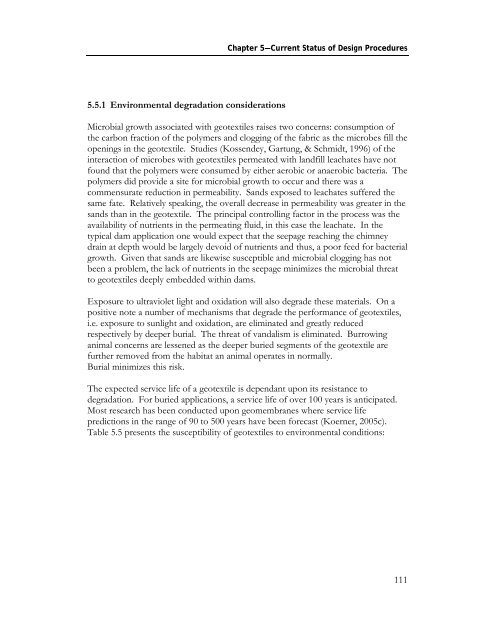Geotextiles in Embankment Dams - Association of State Dam Safety ...
Geotextiles in Embankment Dams - Association of State Dam Safety ...
Geotextiles in Embankment Dams - Association of State Dam Safety ...
You also want an ePaper? Increase the reach of your titles
YUMPU automatically turns print PDFs into web optimized ePapers that Google loves.
Chapter 5—Current Status <strong>of</strong> Design Procedures5.5.1 Environmental degradation considerationsMicrobial growth associated with geotextiles raises two concerns: consumption <strong>of</strong>the carbon fraction <strong>of</strong> the polymers and clogg<strong>in</strong>g <strong>of</strong> the fabric as the microbes fill theopen<strong>in</strong>gs <strong>in</strong> the geotextile. Studies (Kossendey, Gartung, & Schmidt, 1996) <strong>of</strong> the<strong>in</strong>teraction <strong>of</strong> microbes with geotextiles permeated with landfill leachates have notfound that the polymers were consumed by either aerobic or anaerobic bacteria. Thepolymers did provide a site for microbial growth to occur and there was acommensurate reduction <strong>in</strong> permeability. Sands exposed to leachates suffered thesame fate. Relatively speak<strong>in</strong>g, the overall decrease <strong>in</strong> permeability was greater <strong>in</strong> thesands than <strong>in</strong> the geotextile. The pr<strong>in</strong>cipal controll<strong>in</strong>g factor <strong>in</strong> the process was theavailability <strong>of</strong> nutrients <strong>in</strong> the permeat<strong>in</strong>g fluid, <strong>in</strong> this case the leachate. In thetypical dam application one would expect that the seepage reach<strong>in</strong>g the chimneydra<strong>in</strong> at depth would be largely devoid <strong>of</strong> nutrients and thus, a poor feed for bacterialgrowth. Given that sands are likewise susceptible and microbial clogg<strong>in</strong>g has notbeen a problem, the lack <strong>of</strong> nutrients <strong>in</strong> the seepage m<strong>in</strong>imizes the microbial threatto geotextiles deeply embedded with<strong>in</strong> dams.Exposure to ultraviolet light and oxidation will also degrade these materials. On apositive note a number <strong>of</strong> mechanisms that degrade the performance <strong>of</strong> geotextiles,i.e. exposure to sunlight and oxidation, are elim<strong>in</strong>ated and greatly reducedrespectively by deeper burial. The threat <strong>of</strong> vandalism is elim<strong>in</strong>ated. Burrow<strong>in</strong>ganimal concerns are lessened as the deeper buried segments <strong>of</strong> the geotextile arefurther removed from the habitat an animal operates <strong>in</strong> normally.Burial m<strong>in</strong>imizes this risk.The expected service life <strong>of</strong> a geotextile is dependant upon its resistance todegradation. For buried applications, a service life <strong>of</strong> over 100 years is anticipated.Most research has been conducted upon geomembranes where service lifepredictions <strong>in</strong> the range <strong>of</strong> 90 to 500 years have been forecast (Koerner, 2005c).Table 5.5 presents the susceptibility <strong>of</strong> geotextiles to environmental conditions:111
















